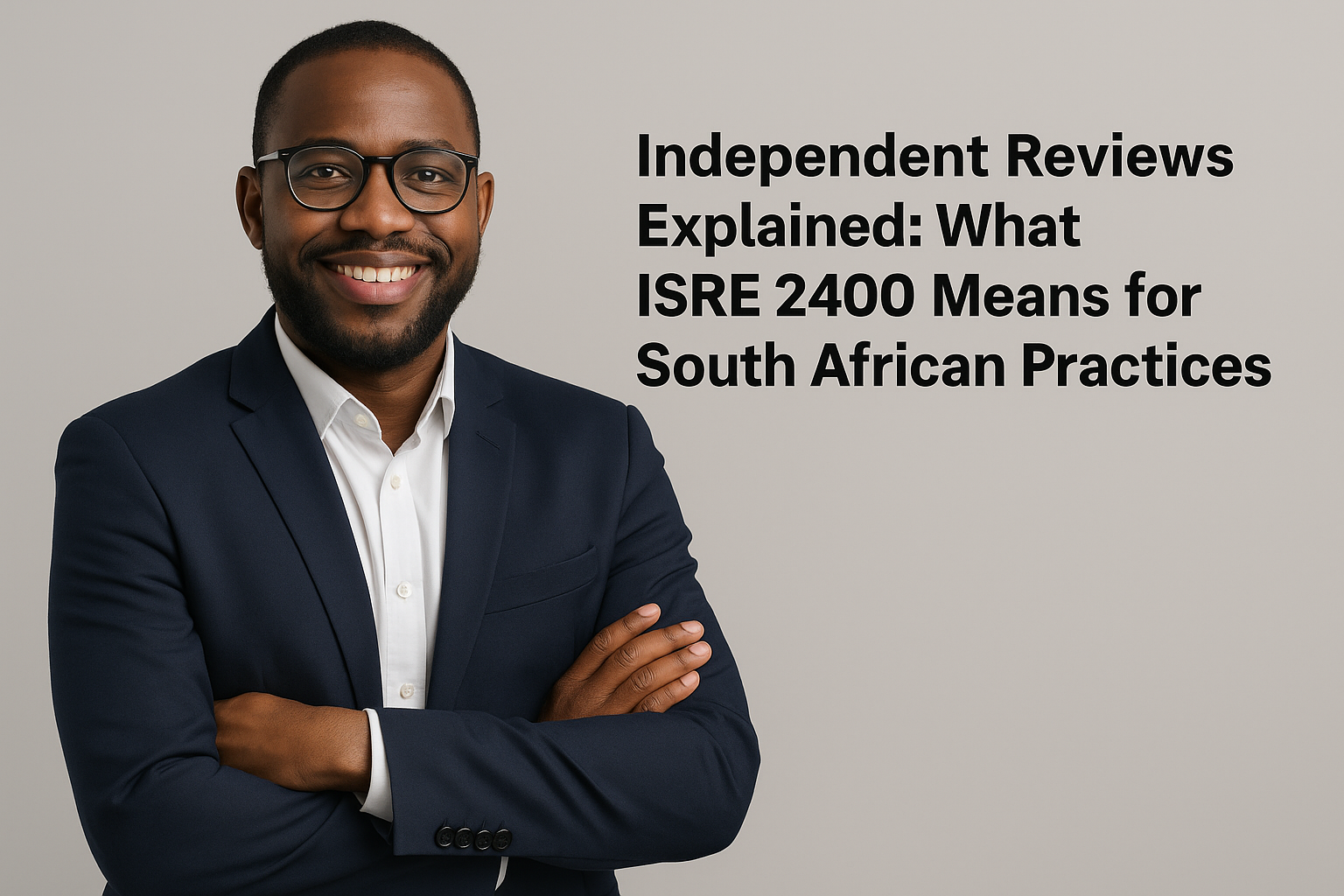B-BBEE Affidavits: Why CIBA Members Must Treat Them as Agreed-Upon Procedures Engagements
B-BBEE affidavits may look quick to complete, but they require more than filling in a form. When a practitioner helps a client with an affidavit, the work must be done as an Agreed-Upon Procedures (AUP) engagement. This means you check only the facts, perform the procedures agreed with the client, and then report exactly what you found. You do not give an opinion, you do not confirm compliance, and you do not provide assurance. You simply state the factual findings from the procedures performed. This protects you and gives the client a correct and defensible affidavit.
Revenue Recognition: Why So Many Get It Wrong
Many business owners still believe revenue is recognised when the customer orders, pays or collects. But accounting does not follow the cash or the excitement of a new order. It follows performance. Revenue is only recognised when you have delivered what you promised and the customer has gained control of it. This simple idea, performance before payment, is the key to getting revenue recognition right and avoiding the common mistakes that distort profits.
Stop Letting Dead Stock Sink Your Business
Every dusty item on a shelf is a silent cash-flow leak waiting to be exposed. Small businesses underestimate how much money is trapped in stock that no one wants to buy anymore. When accountants step in and help identify obsolete inventory, they free up working capital and protect clients from inflated closing stock and SARS problems. This is practical advisory work clients value immediately.
You Can’t Run a Business Without a Proper Chart of Accounts — How to get it right
A Chart of Accounts isn’t an admin checklist — it’s the financial engine that drives profit, compliance, and credibility. Get it wrong, and your reports become chaos. Get it right, and you gain instant control, cleaner audits, and sharper business insights. Here’s how smart accountants turn the COA into a strategic advantage.
No Panic, No Chaos: Helping Clients Become Audit-Ready the Simple Way
When audit season arrives, the tension often builds long before the auditors even walk through the door. The real problem is not the audit itself, but the lack of audit readiness. Missing documents, late reconciliations, and unclear explanations turn a simple process into a stressful one. This article explains how accountants can guide clients toward smoother, calmer and more efficient audits by building simple habits throughout the year. When clients stay organised and proactive, the audit stops feeling like a fight and becomes a powerful tool for trust, growth and better business decisions.
Income Received in Advance: When Money Arrives Before the Work Is Done
When money hits your bank account before you’ve done the work, it can feel like income, but accounting tells a different story. Income received in advance is a promise, not profit. Whether it’s prepaid rent, school fees, or a subscription, this money belongs on your balance sheet as a liability until you’ve earned it. Understanding this simple concept helps businesses stay honest, accurate, and financially sound.
Prepayments: The Hidden Story Behind “Pay Now, Benefit Later”
Prepayments may seem like small accounting entries, but they reveal a lot about how a business thinks about time and value. Paying upfront for future benefits is not just a cash flow decision — it’s a lesson in discipline, foresight, and financial honesty. For accountants in practice, explaining prepayments in plain language can turn a routine adjustment into a powerful conversation about planning, trust, and smarter business. After all, good accounting is not about the past; it’s about making tomorrow’s numbers make sense.
Break-even Made Easy
CVP analysis shows how costs, sales, and profit connect. It helps financial managers and advisors move from reporting numbers to guiding real decisions like pricing, growth, and risk planning. Simple, clear, and powerful, it turns everyday data into strategies that keep businesses profitable and future ready.
Independent Reviews: Asking the Right Questions
Independent reviews are not about ticking boxes or cutting corners. Under ISRE 2400, the true strength of a review lies in asking the right questions. Effective enquiry goes beyond “yes or no” answers , it digs into the story behind the numbers, uncovers risks, and opens doors to valuable insights. When practitioners master this skill, they not only protect themselves and their clients but also transform a statutory requirement into an opportunity to build trust, grow their practice, and strengthen South Africa’s business landscape.
From Numbers to Clues: How Analytical Procedures Crack the Case in Reviews
Analytical procedures are the secret weapon of independent reviews. They save you time, expose hidden risks, and open doors to valuable client conversations. Instead of drowning in invoices, you get to play detective, comparing periods, linking statements, and spotting anomalies that tell the real story behind the numbers. Done well, these procedures turn a compliance exercise into an opportunity to add value and position yourself as the trusted expert.
Planning an Independent Review: Setting the Foundation for Quality
Independent reviews are often underestimated, but the truth is they play a powerful role in building trust and credibility. The key to getting them right is not more checklists or endless procedures, but smart planning. ISRE 2400 (Revised) reminds us that a focused, well-documented plan is the foundation of quality. From setting materiality to identifying risk areas and designing targeted procedures, planning helps practitioners work smarter while protecting their practice. Done right, it turns an independent review into more than compliance , it becomes a valuable service that strengthens client confidence and showcases the professionalism of CIBA members.
Share Sale vs Asset Sale: What Every Practitioner Should Know
Many business owners say they want to “sell their business” without realising there are two very different ways to do it. A share sale means the whole company changes hands, while an asset sale means only the equipment, stock, or contracts are sold. The choice affects tax, risks, and even how the financial records look afterwards. Knowing the difference is vital, and it’s where your guidance as a Chartered Business Accountant in Practice adds real value.
Client Acceptance and Continuation in Independent Reviews
Independent reviews do not start with analytical procedures or management enquiries. They begin with one critical decision: whether to accept or continue with a client. ISRE 2400 requires practitioners to ensure that preconditions are in place, management understands its responsibilities, and independence is safeguarded. Accepting the wrong client exposes the reviewer to unnecessary risk, while a careful acceptance and continuation process protects both the practitioner and the credibility of the profession. For CIBA members, this step is more than compliance, it is the hallmark of professional excellence.
Are You Really Seeing the Full Picture? Why SMEs Shouldn’t Ignore Consolidated Financial Statements
Think It Is Just One Business? Think Again.
Many SMEs unknowingly operate as part of a group — and by ignoring consolidated financials, they could be flying blind. This article looks at why even the smallest “groups” need a full financial picture to make smart decisions, attract funding, and avoid hidden risks. If you're only looking at one entity’s numbers, you're not seeing the whole story. Read below for more practical tips!
The Independent Reviewer: Owning Your Responsibilities Under ISRE 2400
Independent reviews are not just a quick sign-off. Under ISRE 2400, practitioners carry real responsibilities that go far beyond ticking boxes. You are the referee who ensures the game is fair, the professional who applies scepticism when numbers do not add up, and the communicator who helps clients understand the value of limited assurance. When you own your role, you protect the public, elevate your practice, and strengthen the credibility of financial reporting.
Disclosure Requirements: What the AFS Must Say About Financial Instruments
Financial instruments are not just about recording numbers, they also require clear and correct notes in the financial statements. This article explains the disclosure requirements under Section 11 of the IFRS for SMEs, focusing on what SMEs must include in their AFS. We cover key areas like impairment, aging of debtors, maturity of loans, and fair value challenges. You will also see examples of common mistakes and how to fix them. This guide helps Business Accountants in Practice meet their disclosure duties with confidence.
Think Like an Auditor: Make Professional Skepticism Your Superpower
Are you too trusting with your numbers?
Professional skepticism isn’t just for auditors, it’s a critical skill every accountant needs. Whether you’re preparing reports, reviewing documents, or advising clients, asking the right questions can protect your reputation and uncover risks before they become problems. This article breaks down what skepticism really means, how to use it daily, and why it’s becoming non-negotiable in the profession.
Independent Reviews Explained: What ISRE 2400 Means for South African Practices
Independent Reviews have become an essential assurance service for many South African companies that do not require a full audit. Guided by ISRE 2400, these engagements offer limited assurance through a structured process of enquiry and analytical procedures. For Chartered Business Accountants in Practice, understanding the scope, purpose, and legal requirements of Independent Reviews is key to delivering value while staying compliant with the Companies Act. This article explains what ISRE 2400 covers, how Independent Reviews differ from audits and compilations, and when they are required in South Africa.
Impairment Made Easy: When Financial Assets Go Bad
When a customer cannot pay or a loan will not be fully recovered, the financial asset must be reduced. This is called impairment. In this article, we explain how to apply the impairment rules in the IFRS for SMEs Standard. You will learn how to spot signs of impairment, how to calculate the loss, and how to record it. We use simple steps and everyday examples to help Business Accountants in Practice apply the standard with confidence.
Understanding Amortised Cost: The Measurement Model for Most SME Financial Instruments
Amortised cost is one of the most important measurement tools in SME accounting, yet many professionals are unsure how it works. In this article, we explain amortised cost in simple terms and show how to apply it using the effective interest method. You will learn how to measure loans, receivables, and payables correctly, including how to deal with transaction costs and interest. With step-by-step examples and practical tips, this article helps CIBA members confidently apply Section 11 of the IFRS for SMEs in everyday situations.




















